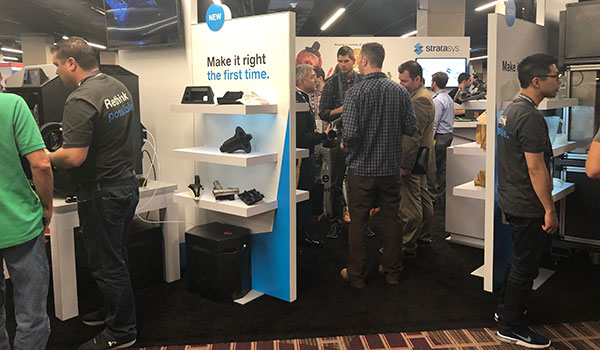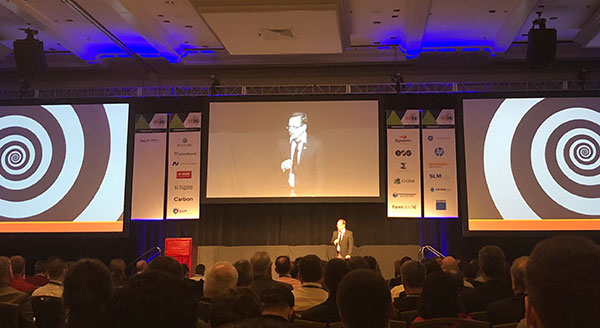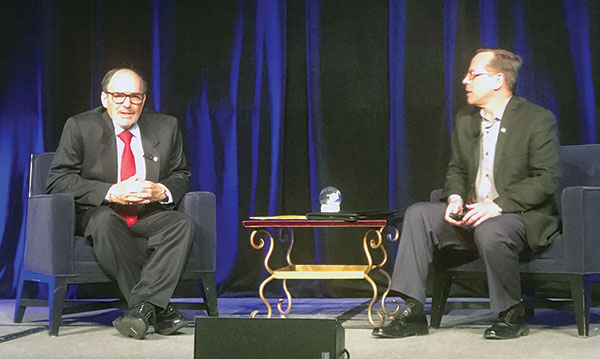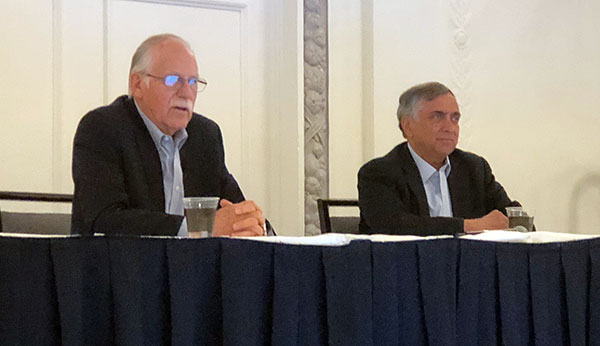Additive Manufacturing Users Gather to Address Challenges, Advance Industry
Materials, software and workflow challenges lead the discussions at the Additive Manufacturing Users Group (AMUG) 2019 conference.

AMUG 2019 attendees in the Stratasys booth to see the new V650 Flex stereolithography 3D printer and F120 3D printer.
April 9, 2019
More than 2,200 people gathered in the Hilton Chicago March 31-April 4 to learn from one another, check out the latest technologies and network at the Additive Manufacturing Users Group (AMUG) 2019 conference. Like the 3D printing/additive manufacturing sector itself, the AMUG conference continues to grow. Now in its 31st year, the volunteer team of conference organizers say this was the largest conference yet.

“You are in an alternate reality right now, at this minute, and you're poised to be in a very significantly different alternate reality,” Todd Grimm, president of T.A. Grimm & Associates, told the AMUG audience after doing his best Rod Sterling Twilight Zone impression. “When was the last time you were in a room with 2,000 people and every single one of them was an additive manufacturing professional? It does not exist out there in the real world.”
Grimm implored attendees to make the best of the alternate reality AMUG creates. AMUG bills itself as “the conference designed for users, by users,” and the 2019 conference lived up to that billing with many networking opportunities, more than 75 exhibitors and hundreds of presentations.
During those presentations and conversations, three topics came up again and again: materials, additive manufacturing software and workflow challenges. In general, there was a sense that additive has come a long way in a short time, but still has a ways to go compared to traditional manufacturing techniques that have thousands of material options, software designed to help design engineers and operators optimize or automate additive manufacturing, and well-established quality control methodologies.
“Will it replace conventional?” asked Professor Gideon Levy of additive manufacturing during his chat with Grimm. “Never ever.” Levy, who is the recipient of the 2019 AMUG Innovators Award, said additive should play to its strengths in terms of what it brings to manufacturing that conventional processes don't, such as designing internal structures, lightweighting and part consolidation.

Additive Manufacturing Materials
John Dulchinos, vice president of digital manufacturing at Jabil, agreed. “It’s still very early in the technology,” he said during a conversation at the conference. “We’re in the first or second inning in an extra-inning game.”
Jabil provides design, manufacturing, supply chain and product management services from over 100 facilities in 29 countries. It recently opened a Materials Innovation Center in Minnesota to deliver 3D printing material solutions under one roof, encompassing polymer formulations, compound development and ISO 9001 Quality Management System certification.
“We decided to do that because every customer meeting we have—they have a set of requirements that can't be met by today's materials,” Dulchinos said. “So we built an entire operation just to serve what we call the long-tail of materials—all the specialty versions of materials that are required to deliver robust solutions. Most of the innovation in the manufacturing world over the last three or four decades has come through materials innovation and we think that should happen in 3D printing.”
It will take time for certified materials to catch up with the thousands of certified materials available for conventional manufacturing processes, especially given the rate of innovation still taking place on the hardware side of 3D printing—innovations that could change the material landscape as well. The industry is tackling that via one use case after another, certifying (and in some cases creating) materials to address real-world challenges.
“There are lots of challenges. In my work, I tend to work on the biggest challenges, and a lot of them are materials,” said Chuck Hull, co-founder and chief technology officer of 3D Systems. Hull, known in some circles as the father of 3D printing for his pioneering work in stereolithography, was interviewed by Vyomesh Joshi, 3D Systems' president and CEO during AMUG. “Imagine in production—there's not three materials, there are thousands of materials and each of them is there for a reason. That's why it's we say 'use case, use case,' to solve each challenge and move to the next one.”

Intersection of Materials, Machines and Software
To provide one use case example, take a look at medical models.
“It used to be that the FDA's (U.S. Food and Drug Administration's) guidance was that you just had to have software that was certified,” said Virginia Goble, vice president, marketing and strategy, Materialise, during and AMUG conversation. “But they recently came out with guidance that you have to have machines and materials certified to have a clinician use that. The machine plus the material has a certification. Same machine, different material, different certification. So every machine-material combination has to be certified individually. The FDA's guidance is evolving, but that's what came out within the last year.”
Materialise has certified machines with Ultimaker, Stratasys, Formlabs and NewPro thus far.
“It is use case by use case,” said Dave Flynn, senior business development manager, Materialise. “There are some process limitations that can be used in additive—whether it's sintering or filaments or photopolymers—not unlike injection molding in that some resins are injection moldable, some are not. The number of useful materials has certainly expanded, but we have a long way to go there.”
Last year, Materialise announced a partnership with BASF to collaborate on materials. The fact that companies like GE, Siemens, BASF and HP were represented at AMUG is sign that the larger manufacturing world is taking additive manufacturing seriously.
Simulation software providers are also taking the technology seriously and working on the considerable challenges involved in predicting what will happen when a particular design using a particular material is 3D printed in a particular machine.
“Part of what we've found from our customers is that it's not enough to have a best piece of simulation,” says Brent Stucker, director of additive manufacturing at ANSYS. “They want simulation in the loop with all the other things they have to do between CAD and print.”
That means topology optimization, lattice optimization, build orientation, support generation, process verification, part distortion, material microstructure predictions, plus post-processing like heat treatment and more should all be in one workflow. ANSYS is addressing that in two ways by developing a complete additive prep and simulation workflow without leaving ANSYS and by working with other companies to integrate with customers' design, product lifecycle management (PLM) and digital twin initiatives. That collaborative spirit is another sign of how additive manufacturing is advancing.
“Any mature ecosystem has to have competition for it to mature,” Stucker says. “ANSYS has always, historically, played nice in an ecosystem. We want to partner with all machine manufacturers and software vendors. What's interesting about AMUG this year is I'm finding, compared to prior years, that everyone is moving in this direction and it's really helped the industry. Machine manufacturers seem much more open to collaborate with all the software vendors and software vendors seem more open to having interoperability instead of trying to monopolize things. I feel that's a sign of maturity. We have to rely on each other.”
#AMUG2019 DINO Winners: Brett Lyons, JABIL; Nate Schumacher, Midwest Prototyping; Bob Markley, 3rd Dimension; Jay Dinsmore, Dinsmore Associates; Rick Moore, US Army; Jeremy Pullin, Sartorius; Rory Jackson, RAMP; Tuan Tranpham, Desktop Metal & Jordan Weston, MSOE. pic.twitter.com/8Kjaa5aZnZ
— Digital Engineering (@DEeditor) April 2, 2019
Connecting 3D Printing to the Digital Thread
Fast Radius is one company focused on that integrated workflow. The company just announced it raised $48M to to expand its platform for production-grade additive manufacturing, which it calls the Fast Radius Operating System.
“People don't often think that additive manufacturing is a supply chain solution, but it is,” said Fast Radius Chief Executive Officer Lou Rassey during an interview at AMUG. “Our view here is that it is not just the tools of production and materials, but there is as much innovation happening in the tools of digital design, simulation and testing on the front end. Then certainly the data and analytics in the production environment upstream of the machine and downstream of the machine—tools of digital metrology and analytics of parts after they're made and then extending that digital thread all the way to shipping the parts to customers and the products while they're in customers' hands. That full thread is where innovation is happening.”
If that sounds ambitious, Rassey said the company is focused on additive and is already creating software for customers that cut across the pillars of discovery, design, make and fulfill. In addition to integrating its customers' different CAD packages into the additive workflow, the company is introducing new tools for additive design evaluation and screening. However, Rassey is aware there are many missing links, highlighting the gap between design and manufacturing, material preparation and formulation, operations during the build and post-processing.
“This digital thread is just being created now, so we're investing at Fast Radius to build out that digital thread ... and there's a lot of opportunity to do that, but still a lot of work to be done. As we do that, we can learn from everything that flows through that thread. That's an area of real opportunity as well.”
There are many opportunities and many challenges to tackle in the additive manufacturing space. Design engineers, machine operators, material formulators, hardware and software vendors need to work together to take advantage of those opportunities on a case-by-case basis. However, there are uses and entire business models that additive manufacturing will enable that we haven't seen yet.
“The future is like the invention of the transistor,” said Levy of additive manufacturing during his time on stage at AMUG. “When it was invented, we didn't know everything it would be used for.”
Some of the current news and new products announced at AMUG 2019 include:
3YOURMIND Launches Agile Manufacturing Execution System (MES) Software
3D Systems Enhances Production Workflow Solutions with Nokia, rms Company and GF Precicast
Stratasys Releases New Configurable, Large-Scale Stereolithography 3D Printing System
HP Produces More Than 10 Million Parts in Last Year Via Multi Jet Fusion Technology
Renishaw to Showcase Multi-Laser AM Innovations at AMUG 2019
XJet to Debut New NanoParticle Jetting Application at AMUG 2019
More 3D Systems Coverage
More Ansys Coverage
More Materialise Coverage
More Stratasys Coverage
More Ultimaker Coverage

Subscribe to our FREE magazine, FREE email newsletters or both!
About the Author
Jamie Gooch is the former editorial director of Digital Engineering.
Follow DE






